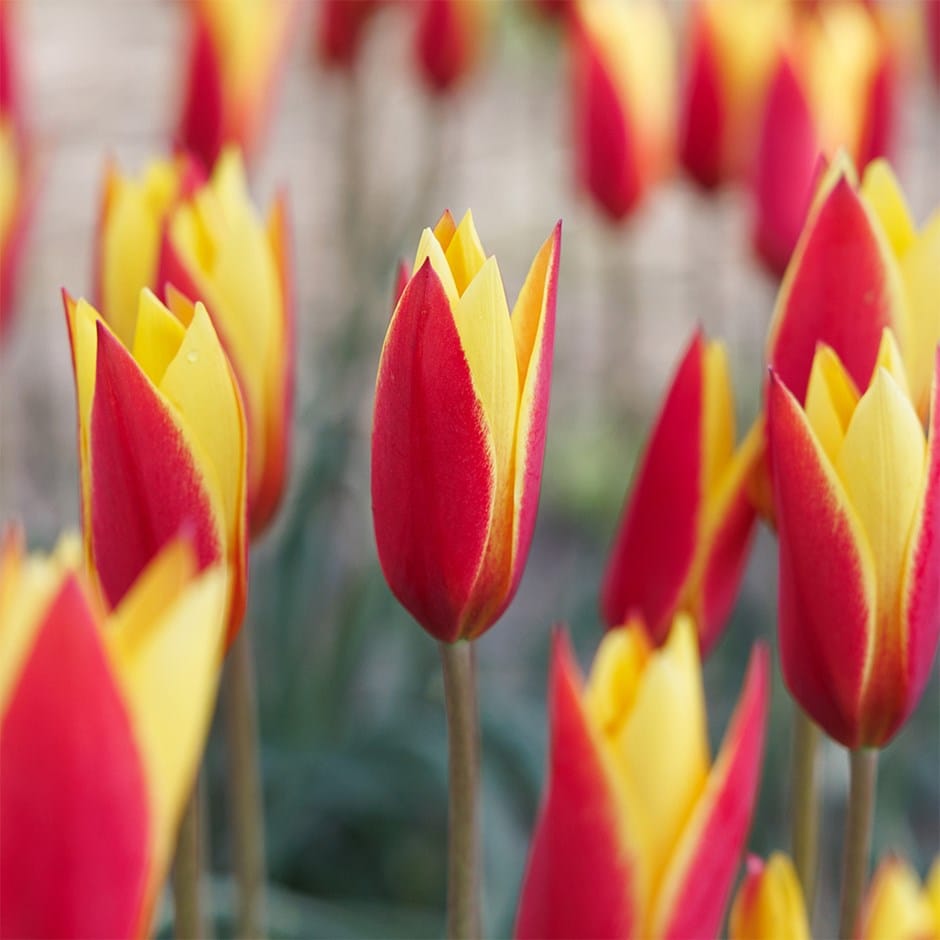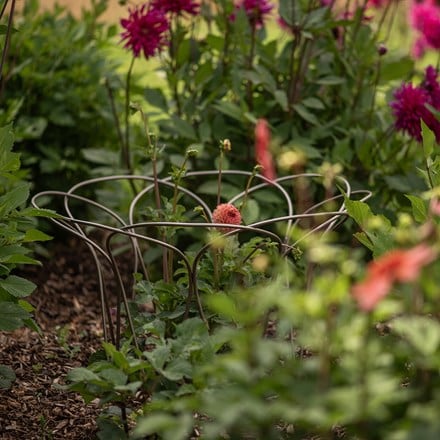Eventual height & spread
Tulipa clusiana var. chrysantha 'Tubergen's Gem'
miscellaneous group tulip bulbs
- 21 × bulbs
- £18.00 £0.86 each
- available to order from summer
- 7 × bulbs
- £6.99 £1.00 each
- available to order from summer
Delivery options
- Bulbs (only) £4.99
- Position: full sun
- Soil: moderately fertile, moist but well-drained soil, or general purpose compost
- Rate of growth: average
- Flowering period: April to May
- Hardiness: fully hardy
- Bulb size: 11/12
A compact, hardy species tulip with narrow, grey-green foliage and vivid, bicolour flowers that appear in mid-spring. Each bloom features bright yellow inner petals contrasted by deep red exteriors, creating strong visual impact when the flowers open fully in sun.
Growing modestly up to 25cm (10in) tall, this vigorous award-winning tulip is well suited to rockeries, meadows, containers or the front of sunny borders. Tulipa clusiana var. chrysantha 'Tubergen's Gem' naturalises well in free-draining soil, returning reliably each year. It’s low-maintenance and ideal for naturalistic planting schemes or mixed with other spring bulbs for layered colour.
Growing modestly up to 25cm (10in) tall, this vigorous award-winning tulip is well suited to rockeries, meadows, containers or the front of sunny borders. Tulipa clusiana var. chrysantha 'Tubergen's Gem' naturalises well in free-draining soil, returning reliably each year. It’s low-maintenance and ideal for naturalistic planting schemes or mixed with other spring bulbs for layered colour.
These species tulips are adaptable for pot and border culture, as well as naturalising in meadows and wildflower schemes. Using fresh, good-quality compost, plant bulbs in pots from September to November. For borders, these tulips have some resistance to Tulip Fire and can be planted earlier in the autumn than other species, though a later planting after the first frosts (October) will reduce any risk.
Plant bulbs 15-20cm (6-8in) deep and 10-15cm (4-6in) apart in fertile, well-drained soil. Alternatively, allow 7-9 bulbs per 30cm sq or 60-75 bulbs per m². If you’re unable to plant your bulbs immediately, they can be stored in a cool environment with good air circulation. Remove all the packaging and place them in a loose-weave jute sack before labelling and hanging up in a dry, unheated garden shed or well-ventilated greenhouse.
In spring, when the potted or border tulips are in active growth, apply a high-potash fertiliser (like Tomorite) each week until the leaves start to die back. Pinch off the spent flower heads as the petals fall, and let the stem and foliage die back naturally. Unlike border/bedding tulips, species tulips tulips can be left in the ground to flower in situ year after year.
If planting in a meadow in order to naturalise, make sure the grass is not cut until the foliage has completely died back.
Plant bulbs 15-20cm (6-8in) deep and 10-15cm (4-6in) apart in fertile, well-drained soil. Alternatively, allow 7-9 bulbs per 30cm sq or 60-75 bulbs per m². If you’re unable to plant your bulbs immediately, they can be stored in a cool environment with good air circulation. Remove all the packaging and place them in a loose-weave jute sack before labelling and hanging up in a dry, unheated garden shed or well-ventilated greenhouse.
In spring, when the potted or border tulips are in active growth, apply a high-potash fertiliser (like Tomorite) each week until the leaves start to die back. Pinch off the spent flower heads as the petals fall, and let the stem and foliage die back naturally. Unlike border/bedding tulips, species tulips tulips can be left in the ground to flower in situ year after year.
If planting in a meadow in order to naturalise, make sure the grass is not cut until the foliage has completely died back.
- Humans: Harmful if eaten; skin allergen; Pets: Ornamental bulbs - not to be eaten


